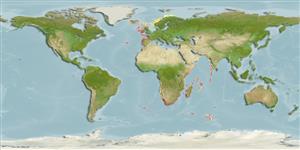Elasmobranchii (haaien en roggen) (sharks and rays) >
Squaliformes (Sleeper and dogfish sharks) >
Squalidae (Dogfish sharks)
Etymology: Squalus: Genus name from Latin 'squalus' meaning shark (Ref. 6885, 27436); margaretsmithae: Named for Professor Margaret Mary Smith, first director of the former J.L.B. Smith Institute (currently
SAIAB).
Eponymy: Professor Margaret Mary Smith née Macdonald (1916–1987) was a South African ichthyologist. [...] (Ref. 128868), visit book page.
Issue
Species information for completion.
Environment: milieu / climate zone / depth range / distribution range
Ecologie
marien; diepte 256 - 284 m (Ref. 116247). Tropical
Eastern Atlantic Ocean from Portugal and Morocco to South Africa.
Grootte / Gewicht / Leeftijd
Maturity: Lm ? range ? - ? cm
Max length : 54.3 cm TL mannelijk / geslacht onbekend; (Ref. 116247)
Korte beschrijving
Determinatiesleutels | Morfologie | Morfometrie
Wervels: 107 - 115. This species is distinguished from its regional congeners (except S. acutipinnis) by having broad pectoral fins that transcend trunk height when adpressed on body, with length of pectoral fin anterior margin 16.5%, 15.9-17.9% TL; differs from S. chloroculus, S. edmundsi, S. lalannei, S. mitsukurii, S. montalbani, S. nasutus by having a smaller snout with prenarial length shorter than distance from nostril to upper labial furrow, and unicuspid and lanceolate dermal denticles (vs. prenarial length greater than distance from nostril to upper labial furrow, and tricuspid and rhomboid dermal denticles); differs from S. megalops, S. brevirostris by having postventral caudal margins that are not uniformly white (vs. postventral caudal margins uniformly white in megalops, brevirostris). differs from S. mahia by having dermal denticles that are wide at the crown (vs. dermal denticles slender at crown in megalops, mahia); differs from S. brevirostris, S. crassispinus by having a shorter dorsal-caudal space, 11.2%, 10.8-12.2% TL (vs. 10.1-10.6% for brevirostris and 9.9-10.0% TL for crassispinus), and from S. mahia, S. crassispinus by the prespiracular length 11.5% TL, 11.7-12.3% TL (vs. 12.4%, 12.4-13.9% TL for mahia and 12.5-12.7% TL for crassispinus); further differs from S. crassispinus by its shorter preorbital length, 6.5%, 6.4-7.0% TL (vs. 7.3-7.4% TL), its larger pectoral fins with pectoral fin inner margin length 9.7%, 9.2-10.6% TL (vs. 8.6% TL), its pectoral fin posterior margin length 11.3%, 11.8-14.5% TL (vs. 9.0-9.4% TL), greater pre-first dorsal fin length, 28.2%, 28.1-32.2% TL (vs. 26.7-27.4% TL), its wider mouth, its widhe 7.6%, 7.8-9.0% TL (vs. 7.4% TL), and shorter pelvic-caudal distance, 25.1%, 24.9-27.2% TL (vs. 27.9-28.1% TL); differs from S. acutipinnis by having a first dorsal fin somewhat upright and rounded at apex, its posterior margin concave at its midline (vs. fin prone and pointed at apex, its posterior margin straight throughout in), caudal fork between lobes discontinuous (vs. continuous), dermal denticles with length greater than width and symmetrical lateral expansions (vs. dermal denticles somewhat equal in length and width, and asymmetrical lateral expansions), its upper teeth narrow, lower teeth depressed, cusp very short and somewhat oblique, straight mesial cutting edge, rounded mesial heel, and apron very short in both jaws (vs. upper teeth broad, lower teeth tall, cusp elongate and directed upward, concave mesial cutting edge, constricted mesial heel, and apron shorter only in upper teeth) (Ref. 116247).
Levenscyclus en paargedrag
Maturiteit | Voortplanting | Paaien | Eieren | Fecunditeit | Larven
Viana, S.T. d. F.L., M.W. Lisher and M.R. de Carvalho, 2017. Two new species of short-snouted dogfish sharks of the genus Squalus Linnaeus, 1758, from southern Africa (Chondrichthyes: Squaliformes: Squalidae). Mar. Biodiv. 1-28. (Ref. 116247)
Status op de Rode Lijst van het IUCN (Ref. 130435: Version 2024-2)
Gevaar voor de mens
Harmless
Gebruik door de mens
Visserij: van potentieel belang
Tools
Speciale rapporten
Download XML
Internetbronnen
Estimates based on models
Fylogenetische diversiteitsindex (Ref.
82804): PD
50 = 0.5000 [Uniqueness, from 0.5 = low to 2.0 = high].
Bayesian length-weight: a=0.00347 (0.00165 - 0.00730), b=3.09 (2.92 - 3.26), in cm total length, based on LWR estimates for this Genus-body shape (Ref.
93245).
Trofisch niveau (Ref.
69278): 4.2 ±0.3 se; based on size and trophs of closest relatives
Weerstandsvermogen (Ref.
120179): laag, minimale populatieverdubbelingstijd 4,5-14 jaar (Preliminary K or Fecundity.).
Fishing Vulnerability (Ref.
59153): Moderate vulnerability (42 of 100).
